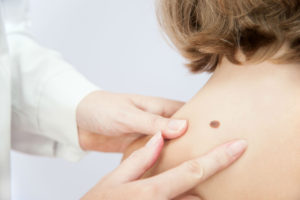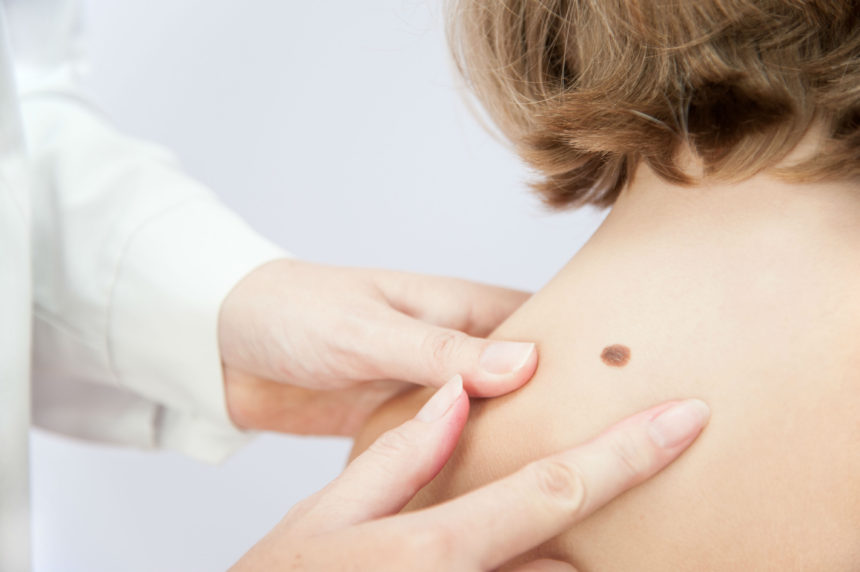Your skin is the largest organ of your body. Do you know what your “normal” is when it comes to your skin? Many of us have freckles, brown spots, and moles, and think nothing of it when a new one appears – especially after spending a lot of time in the sun. It is extremely important to know what your skin looks like, and do a self-examine on a monthly basis. You are checking for any new or changing spots or moles. Although these are usually benign, occasionally a change can signal a cancerous or precancerous lesion. Checking should be done often enough to become a habit, but not so often as to feel like a bother. If you notice something suspicious, see a provider.
Follow this head-to-toe guideline, using a mirror or two to get a clear view:
- Face – Examine your entire face, especially your nose, lips, mouth, and front and back of your ears.
- Scalp – Use a blow-dryer and mirror to expose each section to view or get a friend or family member to help.
- Hands – Check your palms and backs of your hands. Don’t forget to check between the fingers and under the fingernails.
- Forearms – After checking your hands, it’s easy to continue up the wrists to examine both the front and back of your forearms.
- Arms – Standing in front of a full-length mirror, scan all sides of your upper arms beginning at the elbows. Don’t forget the underarms.
- Neck and Chest – Focus on your neck, chest, and torso. Women should lift breasts to view the undersides.
- Back – With your back to the full-length mirror, use the hand mirror to inspect the back of your neck, shoulders, upper back, and any part of the back of your underarms you could not previously view.
- Backside – While standing and using both mirrors, scan your lower back, buttocks, and backs of both legs.
- Lower Body – Sit down and prop each leg on a stool or chair. Use the hand mirror to examine the genitals. Check the front and sides of both legs and feet. Don’t forget between the toes and under toenails. Examine the soles of your feet, too.
 You may find it helpful to have your primary medical provider conduct a full-body exam first to assure you that any existing spots are normal or treat any that are suspicious. After the first few times, a self-examination should take less than 10 minutes – a small investment in what could be a life-saving procedure. A complete skin-check can then be done at your annual physical exam. Feel free to document anything that concerns you with a picture and bring it to your appointment so your provider can compare it to how it looks at the exam, and document any change.
You may find it helpful to have your primary medical provider conduct a full-body exam first to assure you that any existing spots are normal or treat any that are suspicious. After the first few times, a self-examination should take less than 10 minutes – a small investment in what could be a life-saving procedure. A complete skin-check can then be done at your annual physical exam. Feel free to document anything that concerns you with a picture and bring it to your appointment so your provider can compare it to how it looks at the exam, and document any change.
What if you found a spot? Make an appointment with your medical provider and they will determine if a skin biopsy is needed. Skin biopsies diagnose skin conditions, including melanoma and other cancers. The suspected type of cancer determines what type of skin biopsy your medical provider will perform. You will receive a local anesthetic to numb the site before the procedure.
Types of skin biopsy procedures include:
- Shave biopsy – A tool similar to a razor scrapes the surface of your skin.
- Punch biopsy – A circular tool is used to remove a small section of your skin’s deeper layers. You may receive a stitch to close the biopsy site.
- Incisional biopsy – A scalpel is used to remove a small area of skin. You may receive stitches depending on the amount of skin that was removed.
- Excisional biopsy – The entire lump or area of abnormal skin is removed in an excisional biopsy. You will likely receive stitches to close the site. If the cells are determined to be cancerous or precancerous, the suspicious spot is already removed and you are left with the knowledge of what to be looking for!
You skin sample is sent to a laboratory for analysis. In most cases, the result of your biopsy is available within a few days and you will be notified of the results and be provided with additional instructions as needed.
Some cancerous and precancerous lesions can be treated without a scalpel! Cryotherapy is a procedure where a lesion is frozen and thawed several times with liquid nitrogen in order to destroy the abnormal cells and encourage your body to clear them out. Your provider will decide which type of treatment is best for your lesion.
Again, it is the largest organ of your body so take care of your skin all year long. Wear broad-spectrum sunscreen of at least SPF 15. Seek shade, cover your skin with a hat or clothing, and avoid the sun between 10am – 4pm, the most intense part of the day. Avoid artificial UV tanning as well which uses strong rays to accelerate tanning and puts you at risk of developing some cancers. Not only will this help reduce the aging effects from the sun, it will help reduce the risk of skin cancer.


